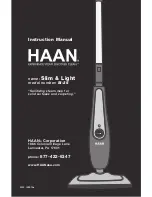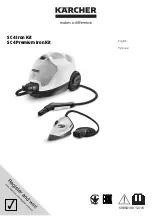
6
Figure 12
Figure 13
Duct
Frame
Power
Supply
Box
Mounting
Holes
Air Flow
Turning
Vanes
Figure 14
Optional method
(Bend tabs outward at 90˚ angle)
Figure 15
REMOVE OLD FILTER AND DISCARD
(Figure 12)
NOTE - The existing filter may be installed inside the air
handler cabinet.
CLEAN BLOWER COMPARTMENT
It is suggested that the furnace blower compartment,
blower and blower housing be cleaned to ensure clean air
circulation.
INSTALLATION
The following is a typical installation of the air cleaner in
an upflow air handler application (Figure 8).
1.
Place the air cleaner on the floor. Stand it upright with
the power door facing you (Figure 4). If a horizontal
installation is being planned, lay the air cleaner on its
side, this will help you to visualize the relative location
of all parts.
Allow ample space for wiring and servicing the power
supply box (Figure 13).
2.
Release the latch, remove the power pack (by grasp-
ing handle and pulling power pack away from cabinet)
and set it aside. Remove the collecting cells and pre-
filters. Set pre-filters and cells aside in a safe location
until the cabinet is installed.
3.
Set the cabinet next to the air handler. If necessary,
enlarge the opening in the air handler (if possible) to
match the opening in the cabinet.
If the air handler opening cannot be enlarged, a
transition fitting should be used. (Figure 3).
The cabinet can be attached directly (Figure 13), or
a starting collar can first be fitted to the air handler
inlet. A butt or slip joint can be used.
Securely attach the cabinet to air handler inlet, using
at least two of the mounting holes on each side of the
cabinet.
4.
Using butt joint, attach duct (normally an elbow) to the
upstream side of air cleaner cabinet. (Note the use of
the sheet metal turning vanes inside the elbow to
improve air distribution over the face of the cells.)
(Figure 14)
NOTE:
An optional method of attaching duct to the
cabinet is to modify the cabinet (Figure 15) by bending the
tabs outward at a 90° angle and attaching duct to tabs.
Transition Fittings
If the air duct does not fit the cabinet opening, a transition
should be used. Gradual transitions are preferred for
greatest efficiency. Not more than four inches per linear
foot (approximately 20° angle) should be allowed (Figure
3).
5.
Connect the vertical duct section to the elbow. Wedge
a wood block between floor and elbow for support
(Figure 16).
6.
Seal all joints in the return air system downstream
from the air cleaner with duct tape to prevent dust
from entering the air stream. Tape is usually applied
on the outside of ducts, but may also be applied on the
inside, or both.
Installation
Improper installation, adjustment, alteration, service
or maintenance can cause property damage, per-
sonal injury or loss of life. Installation and service
must be performed by a qualified installer or service
agency.
▲
!
WARNING
Summary of Contents for EAC-14-2
Page 14: ...14 1 2 2 3 3 4 5 6 8 Replacement Parts...
Page 16: ......
Page 30: ...14 1 2 3 4 5 5 6 2 3 4 8 5 8 5 6 13 10 11 12 15 Pi ces de rechange...
Page 32: ......







































